Eastern Box Turtle
Terrapene carolina carolina
When injured or damaged, the shell of the eastern box turtle can regenerate
Advertisement
Eastern Box Turtle Scientific Classification
- Kingdom
- Animalia
- Phylum
- Chordata
- Class
- Reptilia
- Order
- Testudines
- Family
- Emydidae
- Genus
- Terrapene
- Scientific Name
- Terrapene carolina carolina
Read our Complete Guide to Classification of Animals.
Eastern Box Turtle Conservation Status
Eastern Box Turtle Facts
- Group Behavior
- Solitary
- Fun Fact
- When injured or damaged, the shell of the eastern box turtle can regenerate
- Biggest Threat
- Dogs, ants, snakes, hogs, raccoons, crows, and skunks
- Most Distinctive Feature
- Eastern box turtles can withdraw completely into their shell
- Distinctive Feature
- Eastern box turtles have webbed feet
- Incubation Period
- 50-90 days
- Habitat
- Terrestrial habitats close to ponds and wetlands
- Predators
- Dogs, ants, snakes, hogs, raccoons, crows, and skunks
- Diet
- Omnivore
- Lifestyle
- Diurnal
- Favorite Food
- Young feed onanimal material, such as slugs, worms, insects and larvae. Adults eat plant material, such as seeds, fruits, roots, fungi and grasses
- Type
- Box turtle
- Common Name
- Eastern Box turtle
- Location
- Eastern United States
Eastern Box Turtle Physical Characteristics
- Color
- Brown
- Yellow
- Black
- Orange
- Skin Type
- Hard Outer Shell
- Lifespan
- 25-100 years
- Weight
- 1-2 lbs
- Length
- 5-6 inches
- Age of Sexual Maturity
- 10-20 years
- Venomous
- No
- Aggression
- Low
View all of the Eastern Box Turtle images!
When injured or damaged, the shell of the eastern box turtle can regenerate.
Summary
The eastern box turtle is a species of hinge-shelled turtle, also known as the box turtle. The eastern name is credited to its habitat in the eastern part of the United States. Unlike many other species in the turtle family, eastern box turtles are terrestrial. They can live up to four decades. However, their lives are currently being shortened by human activities. They are slow crawlers and also mature slowly. When in danger, they withdraw their head entirely into their necks and cover their whole body with their shell.
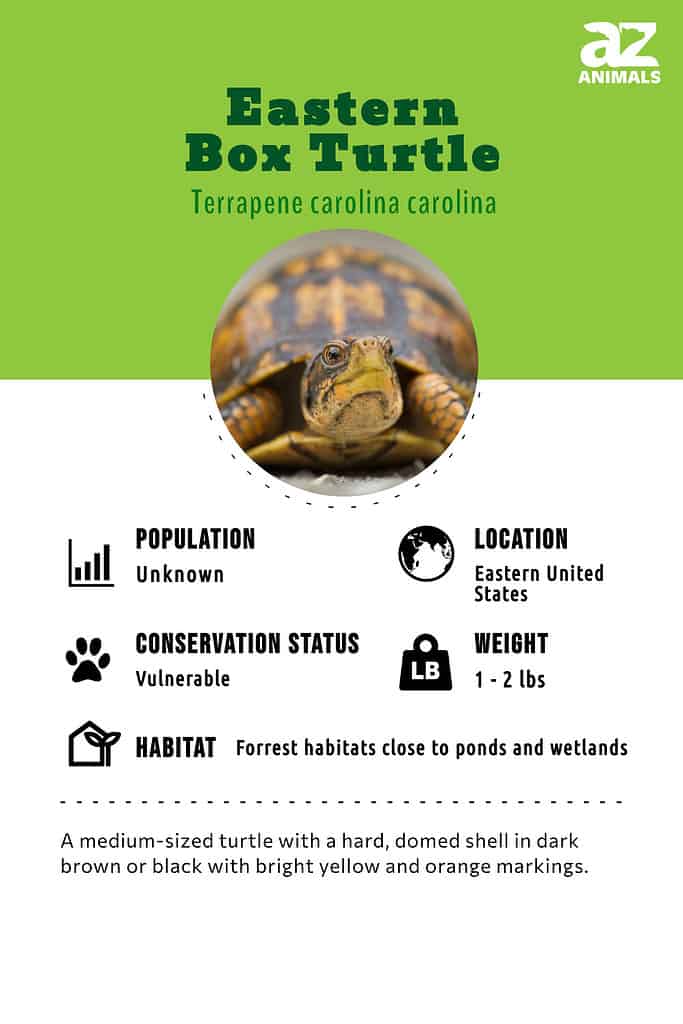
©
Five Facts About Eastern Box Turtles
- These terrapenes lay between 2 to 8 eggs per year. However, they can store sperm in their oviducts, making it possible to produce fertilized eggs years after mating.
- They are peaceful and are not territorial. They can be found in the same location as four other turtles.
- They can live up to 100 years.
- They are early risers and are more active during the day.
- Eastern box turtles’ feet are peculiar. The front feet have five toes, while the back has three or four.
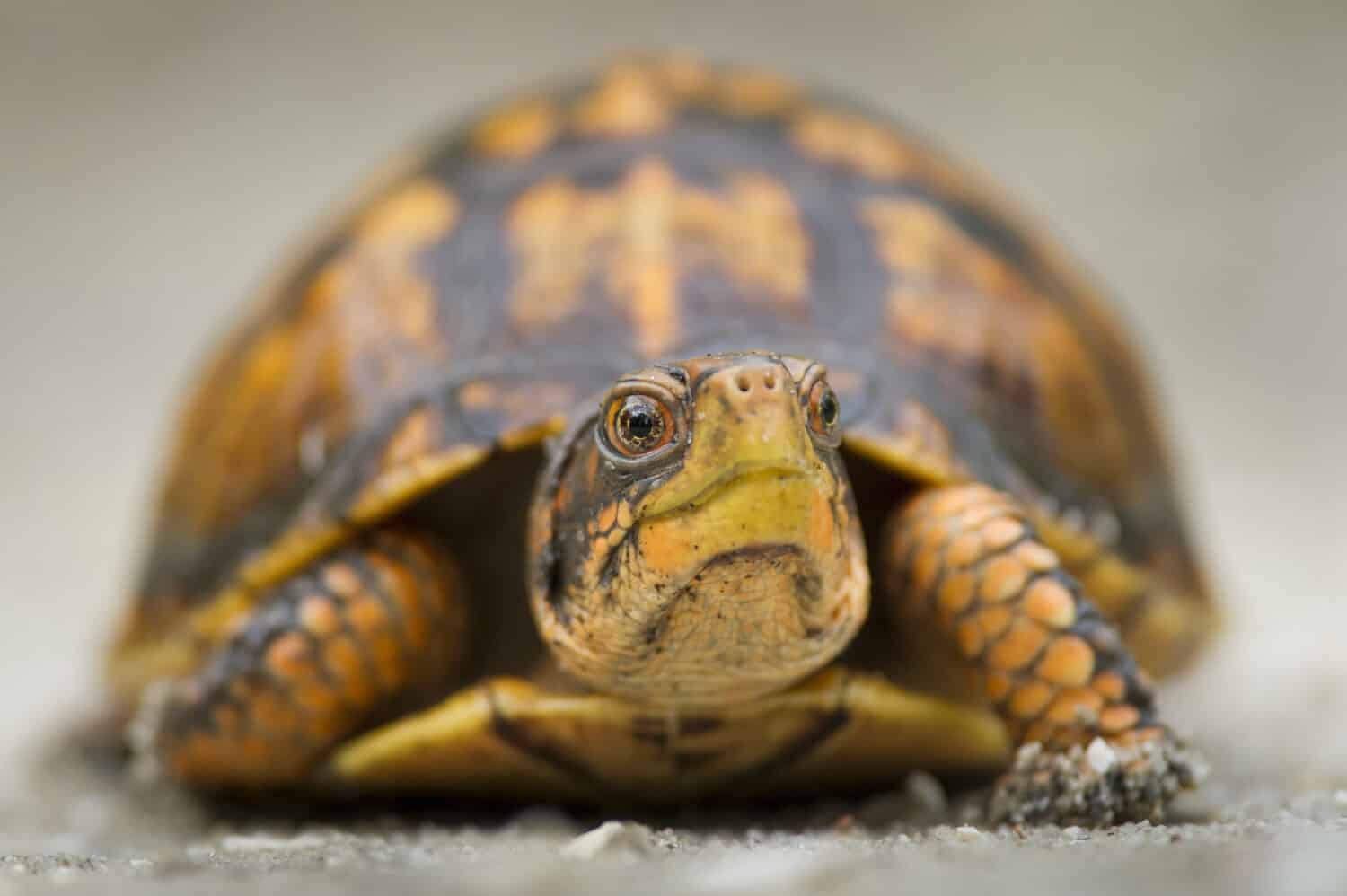
The eastern box turtle is one of six subspecies of box turtle.
Image: Ray Hennessy, Shutterstock
©Ray Hennessy/Shutterstock.com
Scientific Name and Species
The eastern box turtle’s scientific name is Terrapene carolina carolina. It is one of the six box turtle subspecies. The box turtles have a distinctive hinged lower shell, which the turtle can close up completely to enclose itself like a box-hence the name “box” turtle.
They belong to the Terrapene genus, the North American variety of box turtles (different from the Asian variety, known as Cuora). Although box turtles look very similar to tortoises and are more commonly found in terrestrial habitats, scientists classify them as members of the pond turtle family (Emydidae) rather than tortoises.
The common box turtle (Terrapene carolina) has six subspecies. One of them is the eastern box turtle with the trinomial name Terrapene carolina carolina to distinguish it from the common group. The eastern box turtle is the official state reptile of Tennessee and North Carolina.
Evolution

was the earliest known ancestor of the turtle and lived 260 million years ago.
©Smokeybjb / CC BY-SA 3.0 – License
The earliest known ancestor of modern turtles was Eunotosaurus, a reptile that existed during the Permian epoch, around 260 million years ago. Eunotosaurus didn’t have a shell but did have the framing for one with wide ribs that shielded the animal’s underside. Recent studies reveal that those wide ribs aided the animal in digging and burrowing by anchoring it to the ground. Eunotosaurus had evolved to be an efficient excavator. The animal was once thought to be a swimmer but the big claws and thick bones would have helped it to withstand compressive forces while burrowing. The powerful, back-facing front limbs and weaker back limbs indicated a master borrower.
Eunotosaurus fossils have been found in what is now, South Africa, and this turtle relative lived during a period when the land was dry and arid. The animal may have evolved its burrowing ability to escape droughts. Boney rings around Eunotosaurus’s eyes indicate that it may have spent a lot of time underground.
Pappochelys and Odontochelys also seemed to be equipped with digging abilities. It is believed that after the digging adaptations were made – many turtles became aquatic. Over time, complete shells formed from the wide ribcage, perhaps to protect the slow-moving turtles hampered by broad ribs from predators. Digging platforms evolved into suits of armor.
Appearance and Behavior
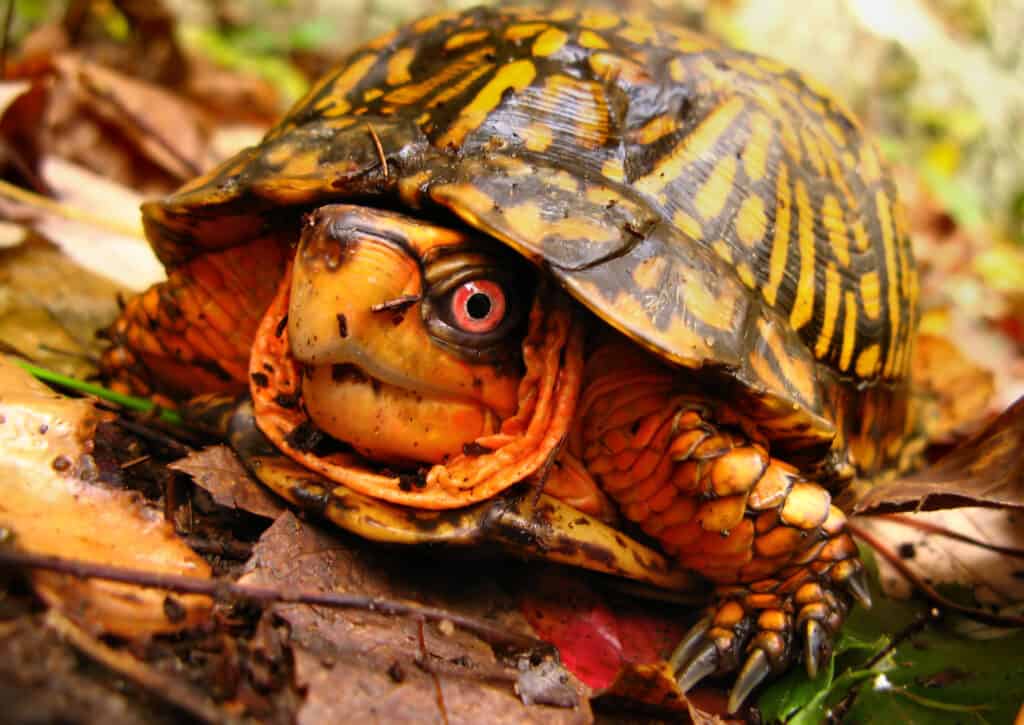
Even though they can not swim, these turtles have webbed feet.
©outdoorsports44/Shutterstock.com
The eastern box turtle has a dome-shaped, hard, and rounded upper shell (carapace). The color of the shell is typically dark brown or black with bright yellow and orange markings. The color is also a camouflage since it is a terrestrial animal that lives around damp fallen leaves with similar coloration.
Eastern box turtles have several features that distinguish them from the other common box turtle subspecies. For instance, the females have a flat plastron, while the males are concave. This allows the males to fit over the female’s carapace when mating.
The shells are hinged, and it has an underside called the plastron. This plastron is what allows them to close their shells completely. When in danger, these terrapenes withdraw into their shells and shut them. This is why they’re called box turtles. Also, as they age, the mid-dorsal keel shells smoothen out. The shell of the eastern box turtle can regenerate when injured or damaged.

Mud burrows offer the eastern box turtle relief from extreme heat and a safe place to hibernate.
Image: Keri Delaney, Shutterstock
©Keri Delaney/Shutterstock.com
Even though they can not swim, these turtles have webbed feet. Their toes are also peculiar as their hind and fore toes are not the same number. The toes on the forefeet are five, while the hinds have three or four each. Box turtles exhibit sexual dimorphism. Males have shorter, thicker, and thick curved claws, while females have long, thin, straight hind claws. Their eye color differs as well. While males have red irises, females have brown.
Eastern box turtles are larger than many of their other subspecies. However, they are not the largest. They can grow up to 4.5 to 8 inches (11 to 20 cm) long and 4 inches wide. They weigh between 0.5 and 2 pounds, with the females being larger than the males.
Habitat

Forests with moist floors make great homes for an eastern box turtle.
Image: Breck P. Kent, Shutterstock
©Breck P. Kent/Shutterstock.com
T. c. carolina is a terrestrial animal; however, it still has some water turtle traits as it likes to be near ponds and wetlands. As their name suggests, they are mostly found in the eastern region of the United States. However, they are also found in southern Maine, Michigan, Florida, and some parts of Texas, Kansas, and Oklahoma.
They stay in diverse forest regions with moderately moist floors and great drainage. In places where they’re found, they mostly prefer bottomland areas instead of ridges or hillsides. They generally prefer shaded habitats with evergreen and deciduous forests or herbaceous grasslands.
Sometimes, they can take baths in shallow streams and puddles. However, they cannot survive in deep water for long. During hot periods, they hibernate in mud and stay there for days, and in winter, they burrow into the ground and stay under the soil until the weather warms up again.
Eastern box turtles have a good sense of direction, especially if they are not far from home. They do not go beyond 1.5 miles of home, so they can easily find their way back. Unlike other reptiles who move from one place to another, eastern box reptiles can live in a place for more than three decades.
Diet

Young eastern box turtles feed on animal material, such as slugs, worms, insects, and larvae. Adults eat plants, such as seeds, fruits, vegetables, roots, fungi, and grasses.
Threats and Predators
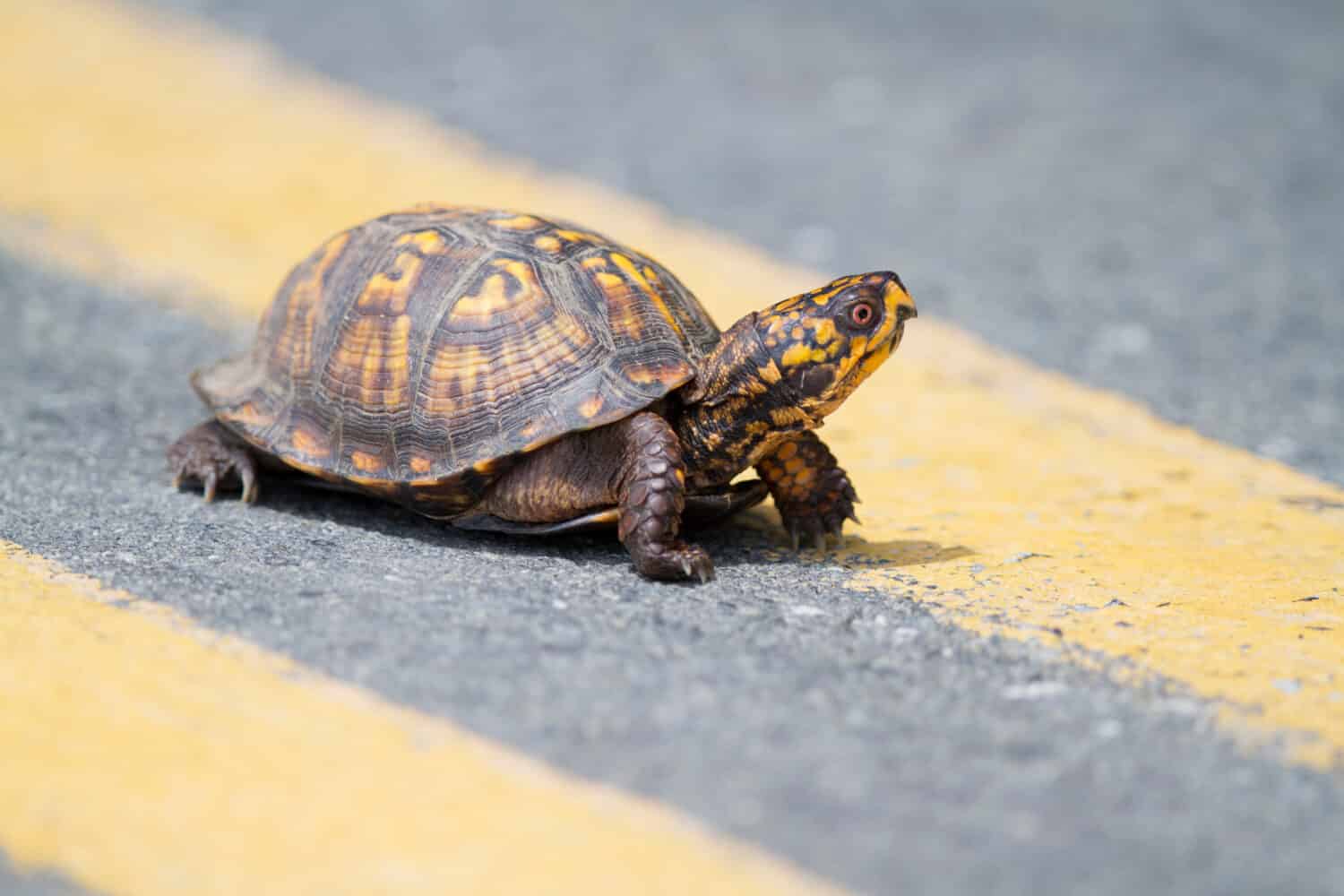
Crossing a road is one of the most dangerous events in a box turtle’s life.
Image: Mark_Kostich, Shutterstock
©Mark_Kostich/Shutterstock.com
Eastern box turtles are now considered vulnerable animals on the IUCN red list. The animals’ main threats are humans and their activities. They are declining in number due to the loss of their habitats. Traffic incidents are also quite common because the turtle slowly crosses the road. Collection for the pet trade is another factor that threatens the group’s survival.
Common predators include dogs, ants, snakes, hogs, raccoons, crows, and skunks. The adults are less preyed upon because of their ability to pull back into their shells. However, their eggs and young ones are still vulnerable to these predators. Box turtles can live a very long life. In captivity, they have been known to live up to 100 years. Their life in the wild is shorter due to predation and disease.
Reproduction, Babies, and Lifespan
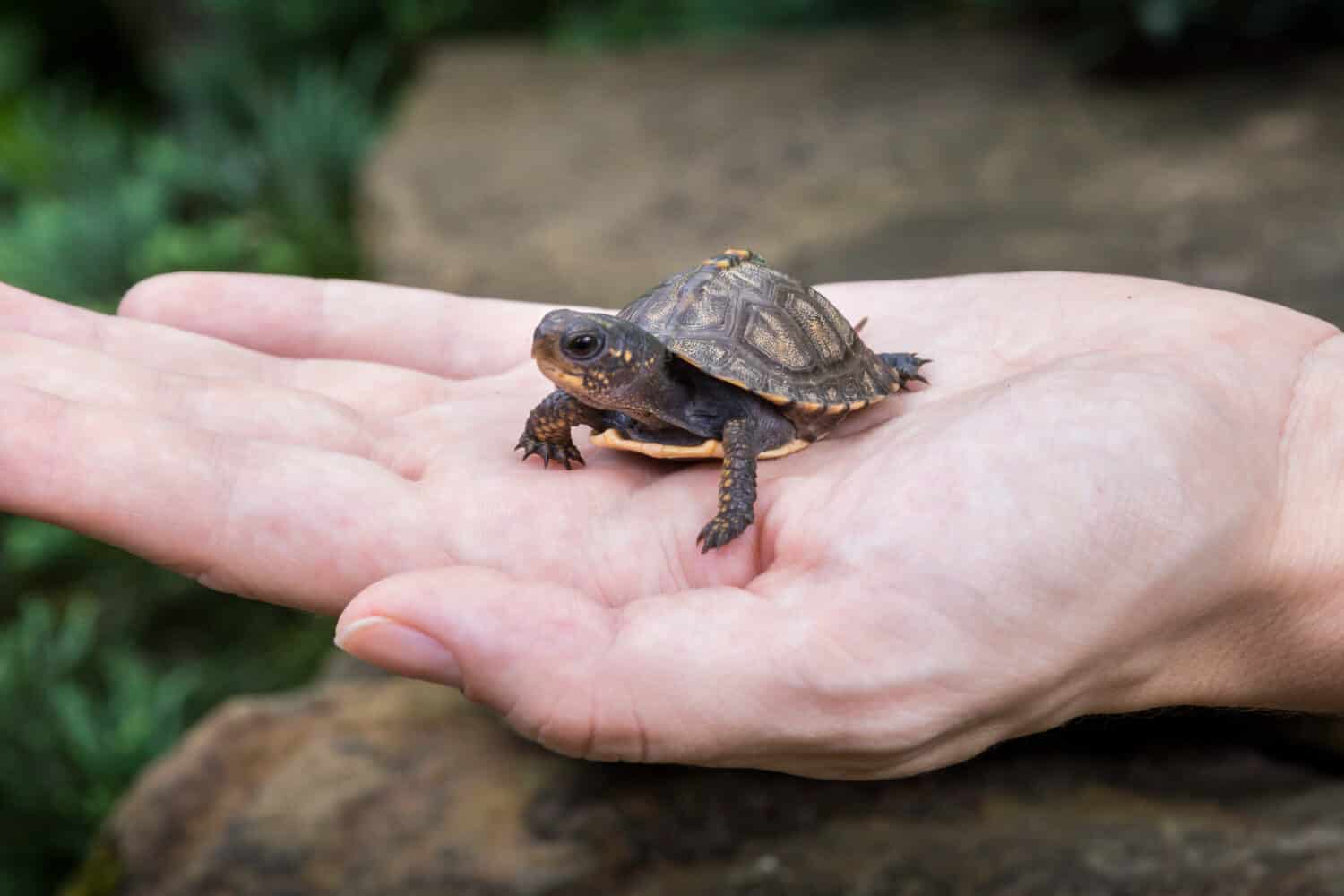
Baby eastern box turtles are tiny and vulnerable to predators.
Image: Jason Yoder, Shutterstock
©JasonYoder/Shutterstock.com
These terrapenes reproduce only a few times in their life. They are egg-laying animals and usually breed during rainy periods between May and June. There is no precise mate-finding mechanism, but they are known to start a three-phase courtship exercise once they find a mate.
The male fertilizes the female’s egg then the female gets a suitable nesting area. This area is carefully chosen as they consider temperature and predation. The temperature can affect the young one’s fitness, sex, and development rate. The female digs the ground to lay the egg and covers it with soil or leaves. The eggs are incubated for 50–70 days before they hatch.
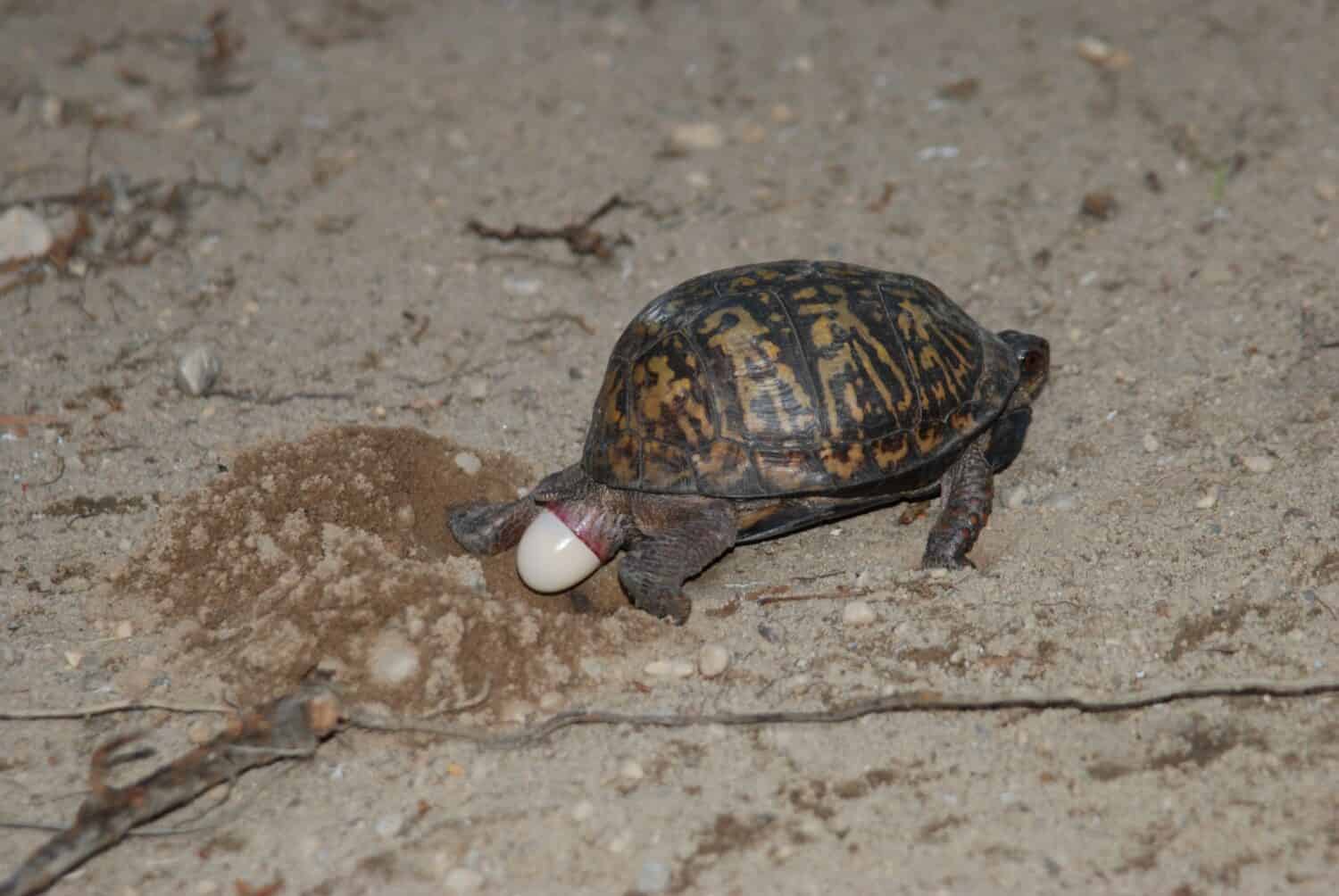
Female eastern box turtles lay their eggs in a hole and cover them with sand.
Image: RAScottPhotos, Shutterstock
©RAScottPhotos/Shutterstock.com
If the environmental factors are unfavorable, the female eastern box turtle can delay fertilization for up to five years by keeping the sperm in its oviducts. On average, female eastern box turtles lay between 1 and 5 clutches of eggs in a year, with each clutch containing about 1–9 eggs.
Population
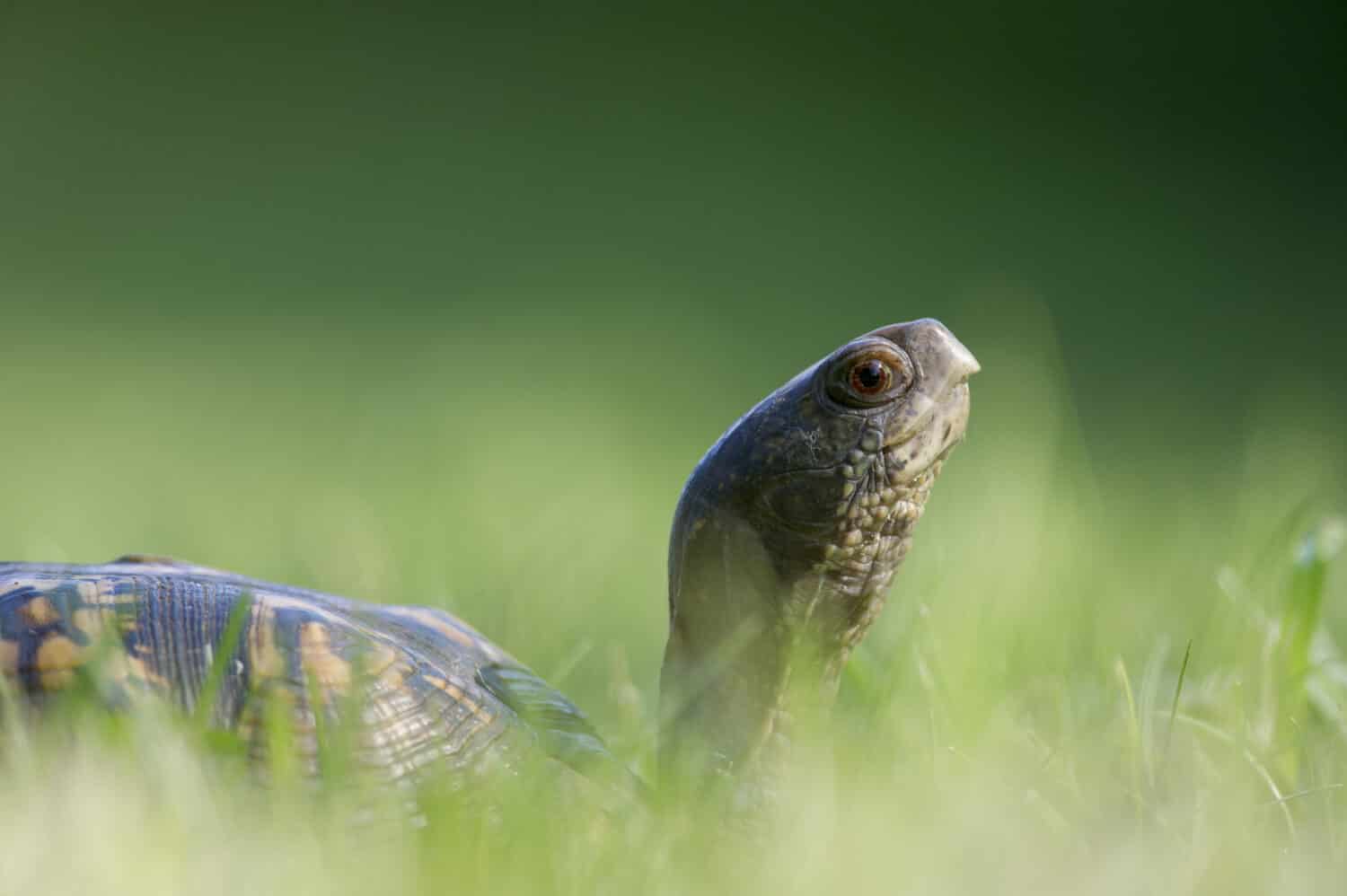
Eastern box turtles’ status has been downgraded to vulnerable by the IUCN.
Image: Ray Hennessy, Shutterstock
©Ray Hennessy/Shutterstock.com
Eastern box turtles have declined rapidly over the past few years, downgrading their status from near threatened to vulnerable on the IUCN red list. There are less than 2,500 eastern box turtles roaming the world. The number is slowly decreasing because these animals reproduce slowly and are still not protected from urbanization in many areas of the world. Other reasons include poaching, disease, and road mortality.
Related Animals
Sources
https://www.britannica.com/animal/Terrapene
https://en.wikipedia.org/wiki/Eastern_box_turtle
https://www.nwf.org/Educational-Resources/Wildlife-Guide/Reptiles/Eastern-Box-Turtle
https://nationalzoo.si.edu/animals/eastern-box-turtle
View all 117 animals that start with EEastern Box Turtle FAQs (Frequently Asked Questions)
Are eastern box turtles carnivores, herbivores, or omnivores?
Eastern box turtles are opportunistic omnivores. This means they’ll feed on almost anything they can find, whether it is plant or animal matter. In fact, eastern box turtles will eat anything as long as it smells or looks edible. Some foods they commonly eat include earthworms, beetles, snails, grubs, and slugs. They may also eat grasses, mushrooms, flowers, and fruits.
Do eastern box turtles like to be held?
Holding eastern box turtles causes them stress which is why they withdraw when held. They perceive handling as a threat to them. So, it is best to ensure they are comfortable with being held and not do it frequently.
Is the eastern box turtle a tortoise?
The eastern box turtle is not related to the tortoise at all. It is a sub-species of box turtle, and it is from the Emydidae family. So despite their physical similarities to tortoises and their predominantly terrestrial habitat, they are not related to tortoises.
Thank you for reading! Have some feedback for us? Contact the AZ Animals editorial team.
Sources
- Smithsonian’s National Zoo & Conservation Biology Institute, Available here: https://nationalzoo.si.edu/animals/eastern-box-turtle
- The National Wildlife Federation, Available here: https://www.nwf.org/Educational-Resources/Wildlife-Guide/Reptiles/Eastern-Box-Turtle
- Wikipedia, Available here: https://en.wikipedia.org/wiki/Eastern_box_turtle
- Britannica / George R. Zig, Available here: https://www.britannica.com/animal/Terrapene

















